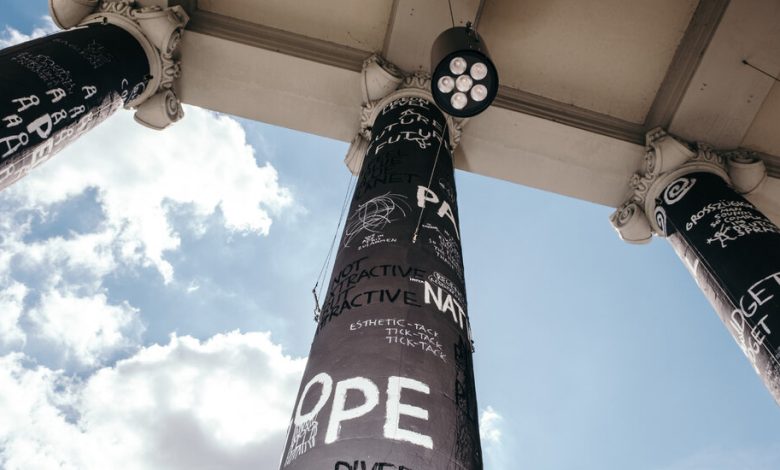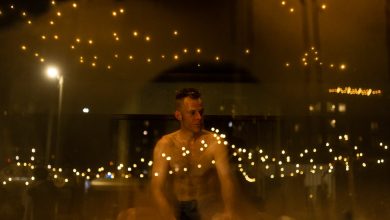The World’s Most Prestigious Art Exhibition Is Over. Maybe Forever.

KASSEL, Germany — It began with a calumny, it ends with a crack-up.
Twice a decade, for exactly 100 days, the world of culture turns its eyes to this midsize German city for Documenta, a giant exhibition whose intellectual ambitions and hefty budgets have ensured its reputation as the world’s most prestigious show of contemporary art. This year’s edition got off to a dreadful start in June, when its most prominent artwork, an agitprop mural incorporating unmistakable antisemitic caricatures, had to be withdrawn amid national outcry. The 15th Documenta now comes to a close on Sunday — not before another controversy that has seen artists, scholars and politicians trade accusations of antisemitism and racism, harassment and incompetence.
When an organizing committee nominated the Indonesian artist collective ruangrupa to organize Documenta 15, we knew an old model was dying; we could not guess how fitfully the new would struggle to be born. This was the first time that artists themselves were tasked to organize what had been, until now, the ultimate curator-led, thesis-driven exhibition. And ruangrupa’s core members blew up their collective decision-making into a larger paradigm, inviting dozens of other art collectives to Kassel, then allowing those collectives to invite participants of their own. The show came together on giant Zoom calls where everyone could forge a big, happy, distributed family they called a lumbung (meaning a rice barn, in Indonesian). This Documenta, unlike any before it, was not about art, or ideas, but about the friends we made along the way — the friends and, indeed, the enemies.
The German press has been scathing. Writers for the country’s brainy national feuilletons have branded the show a “failure,” a “disgrace,” “catastrophic,” and worse besides. Yet Documenta 15 has gotten a warmer reception in the English-language art press, where it has been called “remarkable” and “life-affirming,” and critics have delighted in its disdain for the fetishized art object and, by extension, of the global art establishment. For myself, I left Kassel depressed and disheartened, less by the art itself (which was pretty uniformly forgettable) than by the indifference it showed to its public, and the strange satisfaction it took in being unappreciated.
The original Documenta, staged in 1955 in a Kassel still digging out from wartime rubble, was the first large-scale show of modern painting and sculpture in Germany since the Nazis’ “Degenerate Art” exhibition of 1937. From the start it had civic stakes, and, since the renowned 11th edition, in 2002, Documenta has positioned itself as a Weltkunstschau: a “global art exhibition,”where each artistic director has tried to expand and reimagine the Enlightenment inheritance of the museum to account for a whole world’s creativity. Its influence is huge, and so is its budget: almost $42 million this year, more than double the cost of the Venice Biennale.
Ruangrupa, whose murals and parties felt like a new wave in post-Suharto Indonesia, seemed to promise a less dry and more convivial Documenta, with karaoke booths and a child-care facility on site. Instead of the hard theory and tough viewing of the last four editions, here you could take it easy. But the shock of the antisemitic caricatures — painted by another Indonesian collective, called Taring Padi — has hung over the last 100 days, and it was not the only controversy.
At another large display of Taring Padi’s work, in a former swimming pool, a drawing of a figure wearing a round Indonesian cap was covered by the artists with black tape, lest the hat be mistaken for a yarmulke. (The wearer’s long nose did not help matters.) Other exhibits, including an archival display of brochures from the Algerian independence movement, had to be withdrawn after visitors noticed anti-Israeli imagery that trafficked in antisemitic stereotypes.
Open letters, interviews, demonstrations: None of it calmed Documenta down. Ade Darmawan, a ruangrupa member, was called to testify before Germany’s Parliament. Sabine Schormann, the show’s managing director, resigned. The video artist Hito Steyerl, the most prominent name in the show, withdrew her work — and then, with her customary wit, re-edited it for screening at an off-site Kassel video store.
And then this month came the last, and maybe worst, of this edition’s scandals. It revolves around a film series called the Tokyo Reels, a set of rediscovered Palestinian propaganda shorts found in a Japanese archive several years ago. On Sept. 10, an advisory committee brought in after the mural controversy called for the Reels’ withdrawal. And, writing separately, five of that committee’s members directly blamed ruangrupa and Documenta for “an anti-Zionist, antisemitic and anti-Israel sentiment” that had taken hold of the show.
That was the last straw. Ruangrupa and the bulk of the show’s participants turned the fire back on their accusers in an open letter, lambasting the exhibition managers and the government for “racist and hegemonic agendas,” and alleging that several artists had faced discrimination and abuse while in Kassel. The Tokyo Reels remained on view, but the damage is total and the poison has festered. The artist Tania Bruguera, who signed ruangrupa’s open letter, regretted this week that Documenta was “hijacked,” and that “suddenly, we all had to fear that we would be labeled as antisemitic because we were in this exhibition.”
“It’s something you have to carry with you all your life,” she told the German art magazine Monopol.
The whole thing has rotted into a festival of bad faith and victimology, those twin markers of the Trump-Twitter Decade: rather an irony for a show organized under the sign of friendship. But why did Documenta 15 end this way? Was this the inevitable outcome of Germany’s “memory culture” clashing with the formerly colonized world? Or was there something specific in this show’s method that led to the breakdown?
Well, consider that the uproar over the Tokyo Reels films only arose in the last days of the exhibition, after three months on loop, even as the whole German press was on the lookout for antisemitic content. As projected here, amid masses of pell-mell archival material and TED Talk-style diagrams, the Tokyo Reels weren’t exactly meant to be watched. Viewers began to (pleasantly) space out as they trudged through endless documentation of this or that collective’s meetings or parties, and even the organizers hardly bothered to look at the art on display. The members of Ruangrupa had to acknowledge, when Taring Padi’s banner was taken down, that they hadn’t noticed the antisemitic caricatures before, despite placing the 60-foot work in Kassel’s central square.
This was therefore less an exhibition than what my colleague Siddhartha Mitter, reviewing the show in June, adeptly called “a whole vibe.” Vibing was its aim, and its downfall too. Documenta 15, by design, militated against its own viewing — “the viewer is obsolete,” you can read in the catalog — because the real work of the show was not the stuff on the walls but the hanging out around it. In other words, the actual content and form of these Palestinian agitational movies from the 1970s and 1980s mattered less than the new collective group that brought them here, and the other artists who came together to vibe with them. Collectivity was treated as an end in itself: We were here, as ruangrupa exhorted us, to “Make friends, not art!”
Well, that sounds fun. But what if your friends’ art sucks? This “controversial” Documenta was — to speak of what visitors actually saw in Kassel — the safest and most boring of this century, as evidenced by the almost nonexistent discussion around any of the art on view. Beyond the archival propaganda, it was bloated with show-and-tell displays of workshops you were not invited to, jejune videos that would barely merit a pass in an art school degree presentation, and countless posters and banners worthy of a teenager’s bedroom wall (“This Is My Voice, Listen”), or an N.G.O. training seminar (“Our goal is to respect and honor everyone’s humanity in the space like using people’s chosen pronoun”). Yet for a growing faction in the domain of culture, to complain about the pathetically low standard of the art on view is irrelevant at best, oppressive at worse. Artists matter, not art. Sharing is caring. Pass the beer.
It’s all been a dreadful embarrassment, but why should anyone outside Germany be concerned? Because Documenta was always a pacesetter — and this year’s edition certainly put its finger on a larger shift, seen too in our museums, our art schools and our magazines, away from aesthetic ambition and intellectual seriousness and toward the easier comforts of togetherness, advocacy and fun. If your friends’ art sucks, that’s actually no big deal — because being together matters more than doing something well. And if the German press say your friends’ art sucks, that’s OK, too — reassuring, actually, as evidence that this rotten colonizers’ world has no place for us.
If the “museum of 100 days,” as Documenta is known, returns in 2027, it will likely be with a return-to-order edition, more “conservative” or “market-friendly” than this one. I doubt Documenta will command the respect and the pre-eminence it did before this year, though, and it’ll never recover its aim of imagining the whole world in one show. The dream of a global art world has died, and I fear a lot of people, reactionary and radical alike, prefer it that way. The incomprehension and anger this show has elicited are the proof they always wanted that we have no common future.
But the postcolonial world, to quote a man more serious than most participants at Documenta 15, is not “a vulgar state of endless contestations and anomie, chaos and unsustainability.” The postcolonial world is “a world of proximities,” and the job of an exhibition is to make those encounters productive, meaningful, edifying, beautiful. In art, at least at its best, “the tensions that govern all ethical relationships between citizen and subject converge.”
The man who wrote those words was the Nigerian curator Okwui Enwezor. He wrote them in the catalog for Documenta, which he organized in 2002 — whose rigor and worldliness inspired my career and thousands of others, and whose legacy lies tattered just two decades later. Enwezor, who died in 2019, faced German intolerance head-on throughout his career, and he never gave up on the ideal of global citizenship for the easy pleasure of shared vibes. He certainly did not give up on thinking for the comforts of karaoke.





